
Wine Culture and Information since 2002 - Volume 22
 Wine Culture and Information since 2002 - Volume 22 |
|
Introduction to Gustatory Evaluation of WineAfter having evaluated the aspect of wine and its aromas, it has finally come the right time to take a sip of Bacchus' nectar and to contemplate its soul and essence |
|
The quality of aromas in a wine actually represents the anticipation of what will be confirmed by the taste. The olfactory analysis, pleasing although complex phase of the evaluation of a wine, anticipates the perception of flavors of this beverage, its taste, anticipated by its aromas, certainly represent the most hedonistic aspect of the joys of wine and the examination of wine's taste is what determines the grade of pleasantness and therefore satisfaction. Moreover, the analysis of wine's taste allows the evaluation according to its most loyal ally: food. The gustatory characteristics of wine, as well as the olfactory ones, define in a determinant way the quality and pleasantness of wine, in the very moment a wine is introduced in the mouth, its grade of pleasantness is automatically determined, within few seconds every factor which makes a wine pleasing or unpleasing is evaluated, the nature of those details which disappoint or meet the taster's expectations, the confirmation of what was perceived by the nose is harmoniously corresponding and integrated to the taste and, in particular, the elegance of its balance as well as its proper structure.
|
|
Taste is a rather complex sense, what is considered as “taste” is actually the union of food's flavor sensations and its aromas: the sense of smell contribute in a determinant way to the definition of taste of any food or beverage. The sense of taste, as such, can detect a pretty limited number of stimuli, when compared to other senses, such as smell or sight. Indeed the sense of taste reveals the so called fundamentals flavors (sweet, sour, bitter and salty) as well as other sensations, known as tactile, which, also thanks to the determinant contribution of sense of smell, allow the definition of the taste as a whole. The perception of flavors in the mouth is done by means of the so called “taste buds” which are mainly located on the surface of the tongue. The most common theory about the disposition of the papillae on the tongue, says the perception of each taste is localized in specific parts of the tongue and every area is “specialized” to the perception of a specific flavor. The four fundamental flavors, sweet, sour, salty and bitter, are detected by specific types of taste buds and each of them is capable of generating a sensorial response to the brain according to the flavor it can recognize. The “classic” theory of taste perception about the way taste buds are disposed on the tongue, suggests papillae sensitive to sweet taste are located to the tip of the tongue, the ones sensitive to salty flavors are located on the front sides of the tip, the ones sensitive to sour flavors are located on the sides of the tongue, whereas taste buds sensitive to bitter flavors are located to the back. This theory, pretty known, seems to be denied by a recent and modern research about the perception of taste. It is believed that every kind of taste bud is capable to respond to each of the four fundamental tastes, even though with different intensities and sensitiveness. Moreover it is believed that perception of flavors is not exclusively limited to the tongue, but it is supposed taste buds are also located in the oro-pharynx area, that is the back area of the oral cavity, as well as in the upper tract of the esophagus. Taste buds are made of cells having a stretched shape provided of a cilia sensitive to flavors. These cells are grouped in two or more units, up to 12, and contribute to the formation of each taste bud. The cells sensitive to the perception of taste usually have a life cycle of 7-10 days, when this time has passed they degenerates and are replaced by new cells. Sensibility to flavors is a sense which is present before birth, reaches its maximum development during puberty and generally tends to diminish after 50 years of age. Many researchers have argued on the theory of taste, often proposing new theories and adding new details to what was already known. According to some researchers, fundamental tastes are not four, to the “classic” sweet, salty, sour and bitter tastes should be added tastes of alkaline, meaty and metallic. One point where everyone seems to agree is that taste is the result of the gustatory, olfactory and tactile sensorial perceptions.
|
||||
|
Although tactile sensations cannot be defined or considered as flavors, they contribute anyway to the general perception of taste and, particularly to the gustatory evaluation of a wine, they allow the determination of this beverage's balance and, lastly, the grade of pleasantness. Tactile sensations are perceived in every part of the oral cavity and in the tongue, in particular the central area. Tactile sensations that will be discussed here are thermal, pseudo-caloric, astringency, pungency and consistency or body. Thermal tactile sensation, caused by temperature, besides influencing the perception of flavors and taste, mainly represents a defensive response and its purpose is to detect dangerous conditions for the body in case a too hot or too cold beverage or food is being ingested: the typical reaction is to expel the content of the mouth before being injured. The temperature alters the perception of flavors and, in certain cases, the perception of other tactile sensations. In general terms, low temperatures accentuate the perception of salty, sour and bitter flavors, while lowering the perception of sweet flavor as well as diminishing the pseudo-caloric sensation because of alcohol and makes a wine to appear to have more body and consistency. Lastly, temperature also influences the development and action of carbon dioxide, which is responsible for pungency, a low temperature favors a slow release and pleasantness of this gas, while high temperatures favor a sudden and rapid release. The pseudo-caloric tactile sensation, or causticity, is determined in wine by the presence of alcohol. The more the quantity of alcohol, the more will be the perception of this tactile sensation which can be described as a dryness of the oral mucosa which in turn responds as a “burning” sensation in the whole oral cavity. Astringency is that tactile sensation which is detected when in the mouth is perceived a certain dryness and “roughness” in the whole oral cavity and tongue seems not to move in the mouth with its usual easiness. Moreover astringency also determines a contraction of the gum. This sensation is usually caused by tannins present in wine which have the property of combining with some proteins of saliva and coagulating it, therefore the saliva lose its typical lubricant effect. The sensation of dryness is also because of the inhibition of saliva secretion which is the response to the stimulus of astringency. Pungency is the tactile sensation caused by sparkling beverages because of the effect of carbon dioxide (CO2). This sensation is mainly detected in sparkling wines, however it should be noted this gas is also found, even though in little and negligible quantities, in still wines. The sensation of pungency, that is the effect of carbon dioxide, is also determined by temperature. The tactile sensation of body, or consistency, is that physical perception which allows the definition of the nature of the substance in the mouth, to realize whether it is a liquid, viscous or solid substance. The sensation is perceived in the whole oral cavity and allow the body to “decide” the best treatment for the substance which is in the mouth before being swallowed. In wine it is usually determined by its fluidity, that is by its consistency, and this sensation makes possible the definition, as we will see later, of the body or structure of wine.
|
|
The taste of wines, that is the result of all sensations we talked so far, are determined by many elements dissolved in the beverage. Every gustatory sensation, both flavor and tactile ones, is stimulated by specific chemical substances which make wine. These substances are mainly contained in grape, are the result of fermentation, both alcoholic and malolactic, as well as other substances added during the wine making process, such as tannins passed from cask to wine.
|
|
The gustatory sensations of sweetness and roundness are originated by sugary substances dissolved in wine: sugars contained in the grape as well as alcohol produced during the fermentation process. The main sugars contained in the grape are fructose, glucose, arabinose and xylose. This sugars are present in pretty high quantities, however dependently on the level of ripeness of grapes, and will be subsequently transformed, because of fermentation, into alcohol. According to the style of wine to be made, not all sugars are transformed into alcohol; these sugars are called “residual sugars” and mainly determine the sweet taste of passito and fortified wines. Alcohol, besides being cause of the pseudo-caloric tactile sensation, has a flavor which is fundamentally sweet. Among alcohols produced during the fermentation process, ethanol is the most important one and is produced in high quantities, its presence in a wine depends according to the style. Ethanol, besides contributing to the definition of the gustatory profile of wine, is also responsible for the definition of “roundness' as well as being a fundamental factor for the definition of balance as it actually contrasts the effects of acids and astringency. Moreover, alcohol also provides a fundamental support for primary aromas and to the development of the overall olfactory profile of a wine. Another element produced by the fermentation which is responsible for the sweet taste of a wine is glycerol. This element is present in huge quantities in wines whose grapes have been affected by “noble mold” or “Botrytis Cinerea” which also gives wine a more pronounced roundness.
|
|
The acid taste in a wine is determined by acids dissolved in the beverage and whose origin can be natural, such as acids contained in grape, and acids produced during fermentation. The total amount of acids contained in a wine constitutes the so called “total acidity”, which is made of fixed acidity and volatile acidity. Acids which contribute to the definition of fixed acidity are both of natural origin and of fermentative origin. The most important natural acids present in wine determining fixed acidity are tartaric acid, malic acid and citric acid, whereas the main acids of fermentative origin are lactic acid and succinic acid. The only acid which constitutes volatile acidity is acetic acid which is of fermentative origin. Tartaric acid, also known as grape's acid, is the most important acid of the wine in terms of quantity. When it is present in proper quantities, that is in perfect balance with the other elements, gives wine crispness and liveliness, whereas when it is too much accentuates sourness and astringency. Malic acid has a typical “unripe” and sour taste, is rather unstable and it can be easily transformed, by means of malolactic fermentation, into lactic acid which has a more round taste and it is less aggressive. Citric acid, present in little quantities in wine, gives a pleasing sour taste. This acid can be easily attacked by lactic bacteria and therefore tends to disappear with time. Lactic acid is mainly produced during the “malolactic” fermentation, that is the process started by specific bacteria which transform malic acid into lactic acid as well as producing, as a byproduct, carbon dioxide. Lactic acid contributes to diminish fixed acidity, and by taking the place of malic acid, gives wine a more round and less aggressive taste. Succinic acid, which is produced during the alcoholic fermentation, does not give wine any particular sour tastes, its main role is to determine sapidity and “vinosity” in young wines. Acetic acid, which is surely the least desired acid of them all, is produced during fermentation and is the only acid which determines volatile acidity. Acetic acid is found in any wine and in wines in healthy conditions is present in very little quantities which usually do not influence both taste and aromas. When it is present in higher quantities, it can be easily recognized because of its typical aroma of vinegar and it gives wine a distinctive astringent and sour character.
|
|
Talking about salty taste in a wine is not truly appropriate. The taste in a wine that can resemble salty flavor is produced by mineral acid's salts as well as organic acid's salts and, in general terms, are hardly perceivable in a wine because they are usually covered by alcohol and other volatile substances.
|
|
The taste which resemble bitter flavors in wine is caused by the presence of phenolic and polyphenolic compounds, which are also responsible for the tactile sensation of astringency. This double effect of the phenolic and polyphenolic elements, tannins usually found in red wine belongs to this category of elements, can be cause of confusion because it may happen that a bitter or slightly bitter taste can be considered as astringency.
|
|
Astringency, as opposed to the other sensations discussed so far, is a tactile sensation and, as such, does not have any taste and causes a physiologic reaction, in particular to the secretion and the lubrication efficiency of saliva. Tannins found in wine can be originated both from grape and wine making processes. Grape's stalks, skins and pips all contain tannins. In the production of white wines, the must is not usually left in contact with these parts and therefore it does not contain considerable quantities of tannins. Red wines contains grape's tannins, in particular the ones found in skins as a consequence of their maceration in must. Tannins in wine can also be originated by its stay in casks and the quantity of tannins passed from wood to wine depends on the number of times the cask was used as well as the type of wood used to make the cask: the newer the cask, the higher the quantity of tannins passed to the wine. The astringent effect of the tannins is not always the same, this factor depends both from their origin and from their state, that is their level of polymerization. In young wines tannins' molecules are found in pretty simple forms and have the property of combining with a protein found in saliva, mucin, and by coagulating it, causes a sensation of dryness and roughness, that is the lubricant effect of saliva is considerably diminished. Because of this, tannins which cause this sensation are defined as “aggressive”. During the course of the refining and maturing processes that happen in wine with time, tannins tend to polymerize, that is their molecules tend to group and therefore form bigger molecules, which also are more complex and heavier, and they lose the capacity of combining with saliva, that is they tend to lose their astringent effect. When tannins' molecules reach this state, a condition which is typical in mature and aged red wines, they lose their “aggressivity” and give wine a round and softer character.
|
|
Gustatory evaluation of wine is the phase which follows the olfactory analysis. After having evaluated wine's aromas, the glass will be raised to the mouth and a little sip will be taken, about 15-20 ml (0.5-0.6 oz.), that is a quantity of about two spoons, and this wine will be used to prepare the oral cavity before proceeding with the proper evaluation. Make sure the wine reaches and wets every part of the mouth and therefore it will be expelled or swallowed. This operation is useful in order to remove and “wash away” any possible residual of wine left in any previous analysis while preparing the mouth to receive the next sip of wine that will be properly evaluated. Raise the glass again to the mouth and take another sip of wine of about 10 ml (0.4 oz), that is a little more than one spoon. The quantity to be introduced in mouth is essential in order to achieve a correct and reliable gustatory evaluation: an insufficient quantity would be excessively diluted by saliva and only coarse and ordinary qualities of wine would be perceived, on the contrary, an excessive quantity of wine would make the operation of evaluation difficult. Make sure the wine will reach every part of the oral cavity and move the liquid mass to the front of the mouth. At this point some air will be inspired, through teeth and by keeping the lips almost sealed, in order to favor the volatilization of wine's aromatic elements and this will also accentuate taste and tactile sensations. Move the liquid mass with the tongue while pressing to the palate and make sure the wine homogeneously reaches every part of the oral cavity. At this point exhale air with the nose and start evaluating wine's flavors, and therefore its taste. Sweet substances, such as alcohol and sugars, will be evaluated as well as astringent and acid substances, such as tannins, acids and salts, wine's body and lastly wine's balance. After having evaluated these aspects of wine, the liquid can be either expelled or swallowed. The wine is usually expelled in case the taster is going to evaluate many wines and therefore swallowing every sample, as well as because of the effects of alcohol, would compromise his or her capacity to concentrate and diminish the sensorial capacity. Now simulate chewing movements with the empty mouth and evaluate the so called “persistence”, or length, that is the quantity of time the gustatory and aromatic sensations last in the mouth before attenuating and disappearing.
|
|
As the wine sample is in the mouth, its gustatory characteristics are immediately perceived, the correspondence of flavors with the aromas perceived to the nose as well as its strength, or intensity, of such flavors. The intensity of flavors in a wine is a factor which contributes to the determination of the wine's gustatory quality, its balance and, last but not the least, to determine the best food match. Intensity, in case it is considered by itself, is certainly not a warrant of quality: a wine having a strong intensity of flavors does not mean a quality wine. There are lots of wines whose gustatory intensity is pretty delicate, this does not mean the wine will not be much pleasing or has scarce quality. It should also be reminded that intensity depends on the kind of grape, the wine making techniques, general climate conditions of the vintage and how the wine has been kept.
|
|
Body in a wine is often considered, according to some, as an indisputable factor of quality: greater the body, higher the quality. Indeed, body, just like any other organoleptic factor in a wine, must be expressed in the proper measure and form in order to be in balance with the rest, that is it should not appear as inappropriate or disturbing in the overall gustatory profile. In other words, body, if considered by itself, cannot be regarded as a sign of quality. There are wines, mainly whites, having a very light body, however their elegance and quality is indisputably considered high by anyone. Wine's body is determined by the quantity of suspended or dissolved solid substances in the liquid, the so called “dry extract”, that is the residuals remaining after water has been completely evaporated, which is mainly made of fixed acids, sugars, phenolic compounds, mineral salts, glycerol, gums and pectins, and is mainly responsible for tactile sensations. Body is perceivable by observing wine's fluidity in the mouth, that is the easiness with what it flows in the oral cavity. To better understand this concept, let's consider the fluidity of water in mouth by comparing it with the same sensation caused by a syrup rich in sugars. Water easily flows with no difficulties, whereas syrup, because of the solid substances suspended in it, mainly sugars, seems to flow slower and seems to have a more “solid” consistency. Another example which can be useful in understanding this concept is milk: try to have a sip of skim milk flowing in the mouth, then try the same with a partially skim milk and finally whole milk. Skim milk will be perceived as more “watery” than partially skim milk, whereas whole milk will seem to be more dense and less fluid, that is, it has more body.
|
|
Persistence, or length, is the gustatory and flavor sensation which directly determine the quality of a wine. After having swallowed or expelled a wine from the mouth, the gustatory and olfactory organs will continue to perceive flavors and aromas and they will tend to disappear in a variable quantity of time. Greater the quantity of time these sensation will be perceived, greater the wine's persistence. Gustatory and olfactory sensations perceived after having expelled wine from the mouth is called Intense Aromatic Persistence, and is usually measured in seconds, counting from the moment the wine has been expelled, to the moment the sensations are not perceivable anymore. For example, a wine whose persistence is of 3 seconds is considered as “short”, up to 6 is defined as “pretty persistent”, up to 10, sometimes also 12 seconds, is defined as “persistent”, finally, more than 12 seconds, even though some consider this value to be 15 seconds, is defined as “very persistent”, a characteristic that only great wines have.
|
|
After having swallowed or expelled wine from the mouth, gustatory and olfactory sensations, like we said, continue to be perceived by the organs of sense. These sensations, which are represented by proper gustatory, olfactory and tactile stimuli, allow the determination of the wine's grade of agreeability and therefore its quality. A quality wine, and therefore pleasing, should not leave an “unbalanced” mouth, that is the sensations perceived in mouth must be balanced with the other ones and no one should actually prevail over the others, such as, for example, an evident sensation of astringency or acidity, even worse, unpleasing or faulty flavors and aromas.
|
|
Gustatory balance of a wine represents an essential and fundamental factor for the determination of its quality. A well balanced wine will surely be pleasing and overall impressions left in the mouth will surely be positive. Gustatory sensations take part to the definition of balance and are divided in two categories: sweet elements and other elements. Sweet elements are represented by any substance which fundamentally has a sweet flavor, such as sugar, alcohol and glycerol, whereas other elements will be represented by acids, mineral salts and, in case of red wines, phenolic compounds and tannins. Each category tends to contrast the other, that is to mutually balance, and the proper quantity of elements belonging to both categories is what makes a wine balanced. In order to be balanced, a wine must contain a quantity of sweet elements that can efficiently contrast and balance the other elements, that is to make a balanced gustatory profile where elements of each category do not prevail over the other. The concept of balance varies according to the type of wine which is going to be considered, white or red, both because of the factors which usually make each type agreeable, and because of the nature and quantity of sweet and other elements that make the wine.
|
|
Substances found in white wines and which determine balance are sugar, alcohol and glycerol as sweet elements, acids and mineral salts as other elements. Acidity and crispness is usually a welcome, pleasing and wanted characteristic in white wines, however, in case this sensation is excessively perceivable, therefore covering the sweet elements of wine, sugar, alcohol and glycerol, crispness becomes an unpleasing characteristic and compromise the overall quality of a wine just because it will be unbalanced. A white wine will be balanced when the presence of acids and mineral salts is in proper and pleasing quantity and the perception of sweet elements, sugar, alcohol and other elements which make the wine “round”, are perceivable as well.
|
|
Balance in red wines is somewhat more complex than white wine's balance because of the presence of another element, phenolic compounds and tannins, which play a fundamental role in the determination of red wine's balance. Phenolic compounds and tannins are considered as “other elements” and, just like any other wine, they should be perceivable without covering or prevailing over any other element which makes the wine. A red wine which is too much astringent, that is rich in phenolic compounds, will not be pleasing in case it is not properly balanced by other elements, mainly sweet elements, and a wine which is too much alcoholic will not be pleasing in case it is not properly balanced by acids or tannins. Because of the typical characteristics of red wines, each one of them contain a specific quantity of tannins, varying according to grapes and wine making techniques, and which require a proper quantity of sweet elements in order to be balanced, as well as a proper quantity of acids and mineral salts in order to balance sweet elements. As opposed to white wines, where elements which determine balance are ideally arranged in “opposed lines”, in red wines we also have a third “line”, represented by phenolic compounds which belongs to the “other elements”.
|
Wines of the Month |
|
|
|
Score legend Prices are to be considered as indicative. Prices may vary according to the country or the shop where wines are bought |
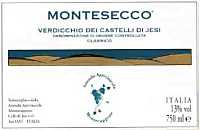
|
|
Verdicchio dei Castelli di Jesi Classico |
|
| Montecappone (Italia) | |
| Grapes: Verdicchio | |
| Price: € 7,40 | Score: |
| The wine shows a straw yellow color. The nose mainly develops fruit aromas of citrus fruit, almond, pear and peach followed by flower aromas of hawthorn and broom and pleasing hints of honey. The attack in the mouth is pleasing, however after a little while, without compromising the good quality of wine, a note of crispness tends to prevail over the rest. Good finish and good persistence with evident flavors of peach and hints of almond. This wine is aged for 6 months in steel containers and 5 months on lees followed by one month in bottle. | |
| Food Match: White meat, Pasta and risotto with fish sauce | |
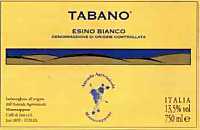
|
|
Esino Bianco Tabano 2001 |
|
| Montecappone (Italia) | |
| Grapes: Verdicchio | |
| Price: € 10,50 | Score: |
| The wine shows a beautiful golden yellow with nuances of straw yellow. The nose has intense and persistent fruit aromas of ripe banana and ripe peach as well as aromas of pear and citrus fruit. The olfactory profile is completed with hints of hawthorn, almond and honey. The attack in the mouth is intense with good a good gustatory profile: alcohol, clearly perceivable and in good quantity, is well balanced by wine's crispness and sapidity. The finish is persistent with evident and pleasing flavors of apple and honey with hints of almond. Esino Bianco Tabano is aged in steel tanks for 6 months and 5 months on lees as well as one month in bottle. | |
| Food Match: Fried fish, Broiled fish, Fish soup, Stuffed pasta | |
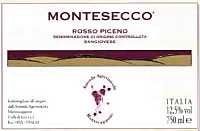
|
|
Rosso Piceno Montesecco 2001 |
|
| Montecappone (Italia) | |
| Grapes: Sangiovese (90%), Montepulciano (10%) | |
| Price: € 7,40 | Score: |
| The wine has an intense ruby red color with nuances of purplish red, pretty transparent. The nose reveals intense and pleasing aromas of black cherry, blueberry and violet. In the mouth has a good body and tannins are well balanced with alcohol, with intense and good flavor of black cherry. The finish is persistent with evident and pleasing flavors of black cherry. This wine is produced by maceration of skins for 5/6 days at a temperature controlled fermentation and is aged for 4 months in barrique and one in bottle. | |
| Food Match: Structured pastas, Sauteed meat, Roasted meat | |
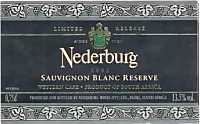
|
|
Sauvignon Blanc Reserve 2002 |
|
| Nederburg (Sud Africa) | |
| Grapes: Sauvignon Blanc | |
| Price: € 6,50 | Score: |
| The wine shows a soft straw yellow color with nuances of greenish yellow, very transparent. The nose reveals the typical aromas of the grape used for its production, very elegant and refined. There can be perceived good aromas of smoky, apricot, banana, tomato leaf, green pepper, pear, peach and elder flower. In the mouth has a good correspondence with the nose, balanced, with a firm crisp attack however agreeable. The wine has good body and the alcohol well balances the wine's crispness. The finish is persistent with evident flavors of green pepper, tomato leaf, elder flower and peach. | |
| Food Match: Fried fish, Aromatic pastas and risottos, Spicy roasted fish | |
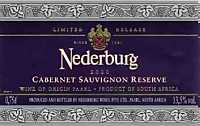
|
|
Cabernet Sauvignon Reserve 2000 |
|
| Nederburg (Sud Africa) | |
| Grapes: Cabernet Sauvignon | |
| Price: € 7,50 | Score: |
| The wine shows an intense ruby red color with nuances of garnet red, pretty transparent. The nose reveals a bouquet mainly oriented to fruit aromas. There can be perceived intense aromas of black cherry, raspberry and black currant as well as hints of violet, tobacco, licorice, vanilla and toasted aromas of wood. In the mouth is agreeable and balanced with flavors having good correspondence with the nose. The wine has good body and tannins well balanced by alcohol. The finish is persistent with pleasing flavors of black cherry and black currant. | |
| Food Match: Broiled meat and barbecue, Hard cheese, Roasted meat | |
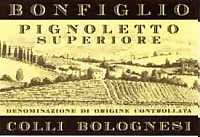
|
|
Colli Bolognesi Pignoletto Superiore 2001 |
|
| Bonfiglio (Italia) | |
| Grapes: Pignoletto | |
| Price: € 8,50 ($10,00) | Score: |
| The wine shows a straw yellow color, very transparent. The nose reveals an intense and rich series of aromas, mainly of fruit, such as citrus fruit, apple, pear and grapefruit followed by aromas of broom, hay, candy, seaweed and hints of yeast. The attack in mouth in pretty crisp, however the wine is well balanced by alcohol. Good correspondence with the nose and mouth pleasing rich of fruity aromas. The finish is persistent with pleasing and clear flavors of citrus fruit and apples. The wine is produced with temperature controlled fermentation in steel tanks. | |
| Food Match: Risotto, Pasta and soups, Fish | |
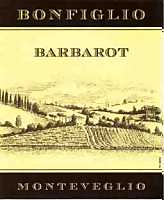
|
|
Barbarot 2001 |
|
| Bonfiglio (Italia) | |
| Grapes: Barbera (90%), Cabernet Sauvignon (10%) | |
| Price: € 9,60 ($9,00) | Score: |
| The wine shows a ruby red color, pretty transparent. The nose reveals the typical aromas of Barbera grape with good correspondence with the mouth. There can be perceived good and intense aromas of black cherry, black fruit, raspberry, blueberry, black currant and hints of violet. The attack in the mouth is pretty crisp, well balanced by alcohol and tannins. A balanced wine, intense and with good body. The finish is persistent with pleasing flavors of raspberry and blueberry. Barbarot is produced with a temperature controlled fermentation in steel tanks followed by an aging of 4 months in bottle. | |
| Food Match: Roasted meat, Hard cheese, Broiled meat and barbecue | |
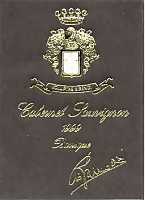
|
|
Colli Bolognesi Cabernet Sauvignon |
|
| Bonfiglio (Italia) | |
| Grapes: Cabernet Sauvignon | |
| Price: € 20,00 ($17,00) | Score: |
| This wine, a good example of Colli Bolognesi's Cabernet Sauvignon, shows a deep ruby red color with nuances of garnet red, little transparency. The nose reveals intense and clean aromas of fruit, of good personality. The perceived aromas are of black cherry, ripe cherry and plum jam with pleasing hints of chocolate, black pepper, undergrowth, vanilla and toasted aromas of wood. In the mouth has good correspondence with the nose and a tannin attack, which is well balanced by alcohol, and good body. The finish is persistent with pleasing flavors of black cherry, plum jam and vanilla. A very well made wine which can be drunk in its current state, however it will give its best with some more aging in bottle. This wine is aged in barrique for 12 months and 6 months in bottle. | |
| Food Match: Stewed meat, Braised meat, Hard cheese, Roasted meat, Game | |
|
||||||||
|
DiWineTaste Polls
|
| |||||||
Privacy Policy | |||||||


| Copyright © 2002-2024 Antonello Biancalana, DiWineTaste - All rights reserved |
| All rights reserved under international copyright conventions. No part of this publication and of this WEB site may be
reproduced or utilized in any form or by any means, electronic or mechanical, without permission in writing from DiWineTaste. |